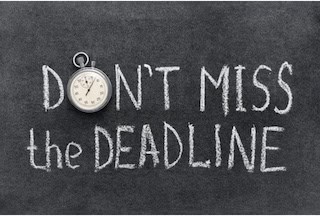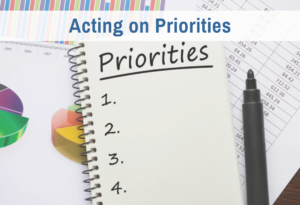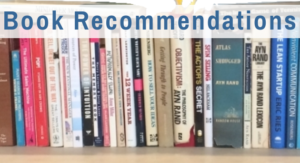If you’ve read my newsletter for a long time, you know a few things about my thoughts related to working on a deadline.
I don’t think it is ever wise to suppress your emotions (barring a literal life-and-death emergency) — a related discussion is here. Based on this conclusion, I gave up acting on the basis of a duty premise (“I have to”) many years ago because that requires suppression.
This creates a conundrum for getting things done on a schedule. To follow through without pressuring myself, I’ve developed an alternative to self-discipline, which I call self-direction. It is an entirely value-oriented means of following through in action on intentions. It eliminates self-criticism, self-deprivation, and forcing oneself.
Self-direction enables you to continue taking steps forward when work gets emotionally difficult. It is all you need for doing routine work, i.e., work that doesn’t require a lot of creativity. It results in success, usually sooner rather than later. But it often requires you to reconceive the goal or the deadline in order to keep going at a sustainable pace.
This is particularly true if you use self-direction for long-term creative work like writing. Although my writing output has gone up considerably thanks to self-direction, I still have difficulty sticking to deadlines for writing work — such as getting newsletter articles written to go out on a Sunday. I thought I’d share a few thoughts on what I’ve been doing to develop other tools that augment self-direction to make that possible.
The need to be able to estimate time accurately
The first skill I worked on is the ability to accurately judge how much time it will take for me to write an article.
When I first started writing articles for newsletters (in 2004), it took me anywhere from 4 hours to 15+ hours to write an 800-word article. Worse, after considerable effort, I often realized that the idea underpinning the article was off. I would scrap the article and try again. There was one memorable attempt in which I abandoned an article (properly) after 30 hours of work.
My first breakthrough in writing predictability came in 2008 when, after aborting an article, I decided I needed a writing process to ensure that my idea was viable sooner rather than later. (The process I developed is taught in the Thinking Lab in my Nonfiction Writing Course.)
A writing process helped a lot. Since then, I have gradually improved my predictability so that if I come up with a simple topic — one that I know cold — it takes me only about 4 hours to write an article of 1,000-2,000 words.
The need to learn when you work best
However, it’s not enough to allot any four-hour period on the calendar to write. Writing takes “focus time,” meaning total concentration without interruptions for maximum creativity. Two hours of focus time at one sitting is about the longest time that can be sustained without a half-hour break.
I usually recommend people schedule one focus time block per weekday. When to schedule it depends on your idiosyncratic schedule. A lot of people (including me) schedule it first — before checking email. Some people are better off doing it in the afternoon or the evening. It’s something you need to discover yourself.
What I did (and recommend) is to develop a “scheduling infrastructure,” a personalized plan for work that meets my particular mental needs. For example, in addition to doing all writing before admin or email, I don’t schedule appointments before 2 p.m. I start the day with a fixed “get started” routine that gets my mind in gear. I have particular kinds of breaks (food, exercise, music) that I use to transition between tasks. All of this I figured out by experimentation to see what was most effective for me. This self-understanding also let me increase my capacity.
With a lot of training, I can now sustain 10 blocks of focus time a week (2 blocks per weekday), because I maintain a value orientation in the block. The rest of the workweek is filled with other less demanding work (teaching, email, meetings, admin, etc.), but 10 hours is a hard upper limit on how much serious intellectual time I can invest. That has helped me be more realistic about what I attempt to do.
Scheduling the week
Despite a lot of progress, I still could not predict my schedule in advance. I was regularly overcommitted. Brooke Castillo convinced me that the solution was to learn to schedule the entire week and stick to the schedule. I needed to do this to eliminate boom and bust cycles of productivity. I still wasn’t 100% clear on how much work I could sustain.
The problem is that “my eyes are bigger than my stomach.” I am so excited by my work that I am always eager to add on some feature to the Thinking Lab or some new offering. But that leads to impossible conflicts. Too often, the weekly article was the work that was dropped to make way for the idea du jour.
The reason to stick to the schedule is to get objective data about your capacities. That has been my project over the last few years. It’s been eye-opening. I discovered I needed to schedule more downtime and more sleep time. And I realized I cannot add new projects at will. And that I need to schedule a couple of TBD blocks of time toward the end of the week to deal with surprises that come up during the week.
All of this is making me more predictable and the newsletter is more regular, but it is not the whole solution. I still get inspired to write on a topic, then discover a couple of hours into it that there is a flaw in my idea. The article falls apart. In the past, that has resulted in no newsletter.
Dealing with plans that fall apart
This failure happened this week. Twice. Twice I came up with a topic, put in a couple of hours, and then saw it fall apart. I will not try to communicate those two topics because it is clear that I am not ready to write on either of them.
But because I was committed to getting an article out, I did get one level clearer on the problem. Here’s my observation:
When the plan falls apart, you are likely to experience self-doubt. You have just discovered that you don’t know as much as you thought you did, or you are not as skilled as you thought you were, or you are not as clear on your values as you thought you were. And you are about to fail (literally) at a task you committed to.
Self-doubt is a horrible feeling. It takes emotional resilience to stay grounded when you feel self-doubt. There is no pollyanna positive self-talk that can wipe it away. It is the feeling you have when you stumble upon your own unexpected limitations. My general advice for dealing with self-doubt is to activate a self-esteem context. This is a process that helps you accept reality and focus on whatever is the top value at stake.
In hindsight, my willingness to experience self-doubt and learn something from it has been the superpower behind my intellectual growth over the last 30 years. Today, I got evidence that I’m getting faster at processing it. I was able to recover from the second failure, pull out a couple of nuggets to share, and write this article in two more hours.
This doesn’t mean I will never miss a newsletter deadline again. But it does mean that I have a new level of skill in sticking to my guns and following through on my intentions to write an article and send it today. I’m celebrating tonight!









0 Comments